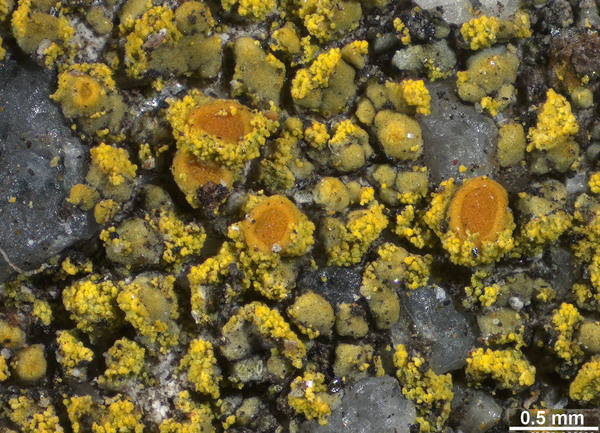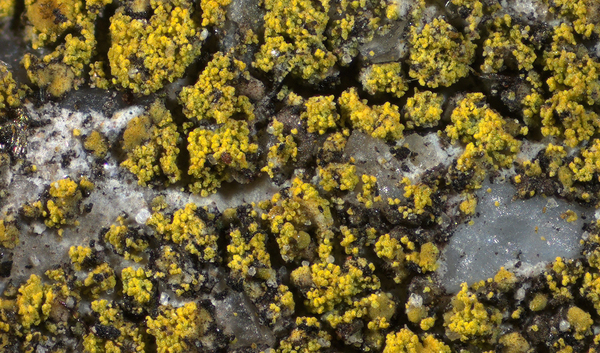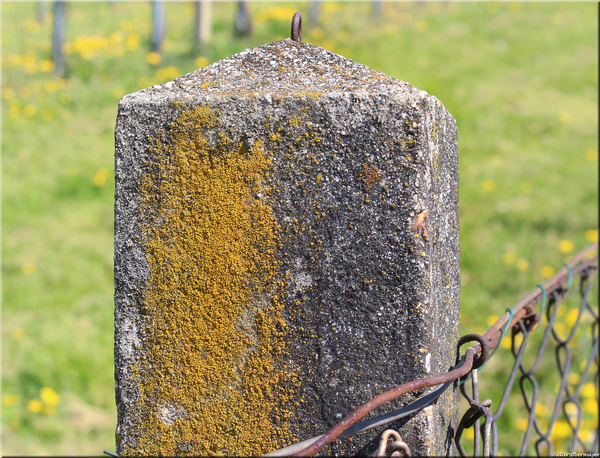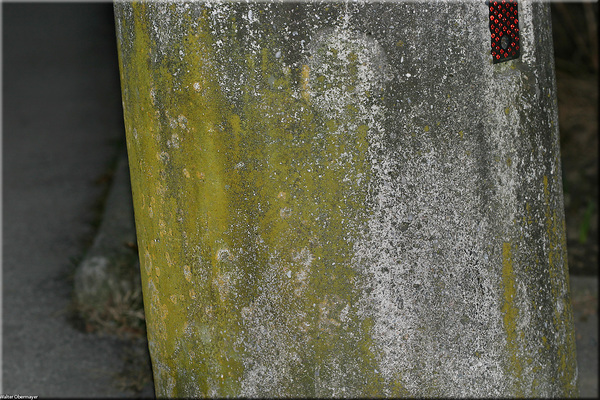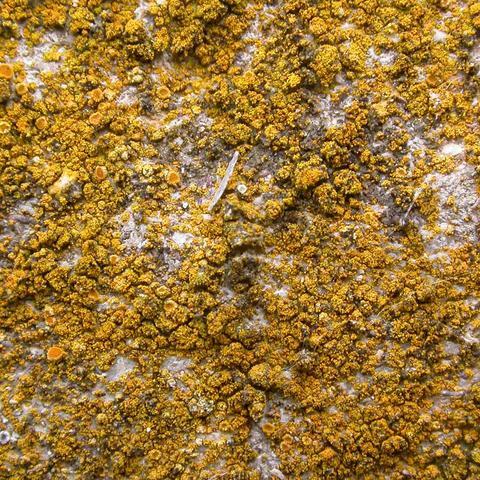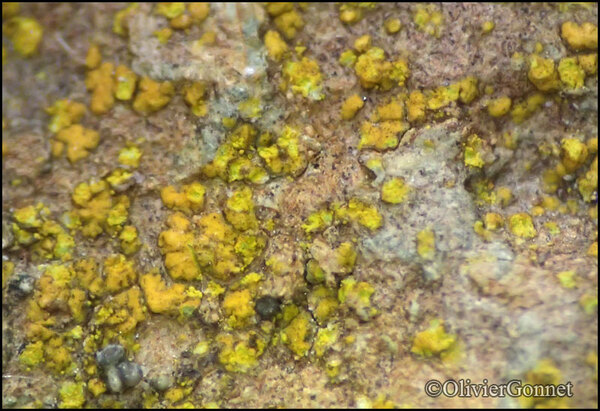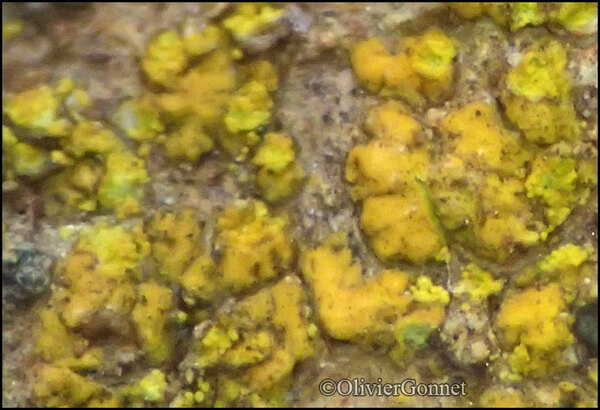Flavoplaca austrocitrina (Vondrák, Ríha, Arup & Søchting) Arup, Søchting & Frödén
Nord. J. Bot., 31: 44, 2013. Basionym: Caloplaca austrocitrina Vondrák - Ríha, Arup & Søchting in Vondrák & al., Lichenologist, 41: 588, 2009.
Synonyms:
Distribution: N - Frl (TSB 546).
Description: Thallus crustose, episubstratic, yellow, areolate or formed of aggregated, corticate squamules which are (in average) 190 μm thick and 0.7 mm wide, flat, smooth, with marginal soralia which in old thalli may cover the whole surface. Soredia (22-)26-46(-61) μm in diam., sometimes gathered into consoredia. Apothecia zeorine, 0.3-0.6 mm across, with a flat to convex disc, and a sorediate thalline margin which, in young apothecia, is hidden below the proper margin, becoming more evident in old apothecia. Epithecium orange, K+ red; hymenium colourless, 60-80 μm high; paraphyses simple or sparingly branched, the apical cells 3-6 μm wide. Asci 8-spored, clavate, functionally unitunicate, apically thickened with a broad internal beak, the inner part of apex and external cap I+ blue, Teloschistes-type. Ascospores 2-celled, polarilocular, hyaline, ellipsoid, in average 11 x 6 μm, the equatorial thickening (“septum”) c. 4.5 μm. Photobiont chlorococcoid. Spot tests: thallus, soredia and apothecia K+ red, C-, KC-, P-. Chemistry: thallus and apothecia with parietin (major), fallacinal, emodin, teloschistin and parietinic acid (minor), corresponding with chemosyndrome A of Søchting (1997). Note: a species of the F. citrina group with an areolate to subsquamulose, usually yellow to greenish-orange thallus and marginal soralia, apothecia not rare; mostly on artificial substrates like concrete or mortar in strongly manured places, e.g. in sites visited by dogs; certainly much more common and hidden behind records of F. citrina.
Growth form: Crustose
Substrata: rocks
Photobiont: green algae other than Trentepohlia
Reproductive strategy: mainly asexual, by soredia, or soredia-like structures (e.g. blastidia)
Pioneer species
Commonnes-rarity: (info)
Alpine belt: absent
Subalpine belt: extremely rare
Oromediterranean belt: absent
Montane belt: rare
Submediterranean belt: common
Padanian area: common
Humid submediterranean belt: common
Humid mediterranean belt: rather common
Dry mediterranean belt: rather common
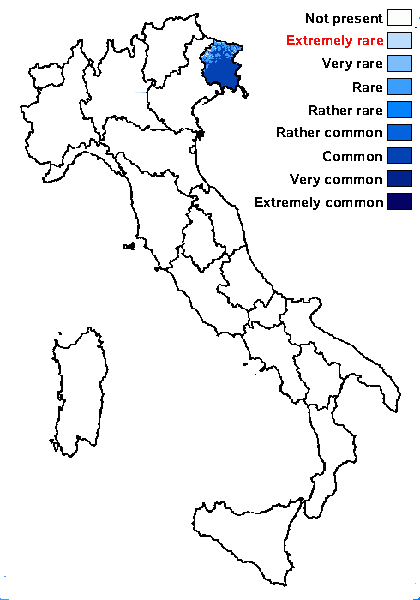
Predictive model
Herbarium samples
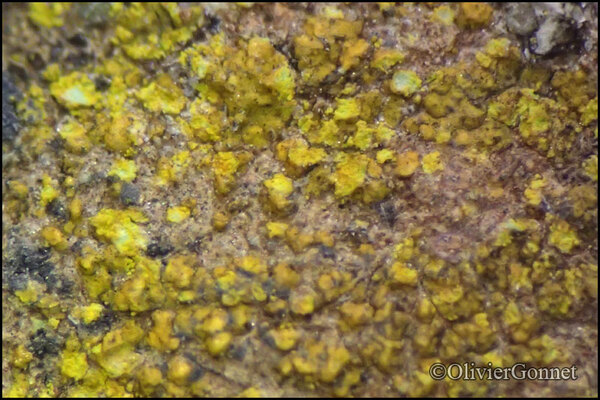
Courtesy Danièle et Olivier Gonnet - Source: https://www.afl-lichenologie.fr/Photos_AFL/Photos_AFL_F/Texte_F_1/Flavoplaca_austrocitrina.htm
France, Ile Cavallo, alt : 29 m - Corse
14/3/2014
cf.
Growth form: Crustose
Substrata: rocks
Photobiont: green algae other than Trentepohlia
Reproductive strategy: mainly asexual, by soredia, or soredia-like structures (e.g. blastidia)
Pioneer species
Commonnes-rarity: (info)
Alpine belt: absent
Subalpine belt: extremely rare
Oromediterranean belt: absent
Montane belt: rare
Submediterranean belt: common
Padanian area: common
Humid submediterranean belt: common
Humid mediterranean belt: rather common
Dry mediterranean belt: rather common

Predictive model
| Herbarium samples |

 Index Fungorum
Index Fungorum
 GBIF
GBIF
